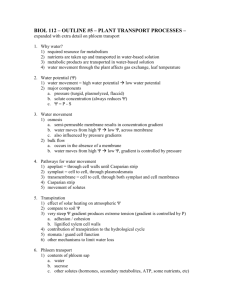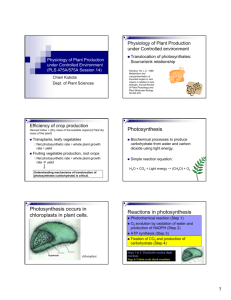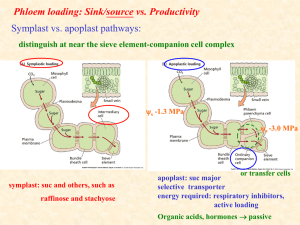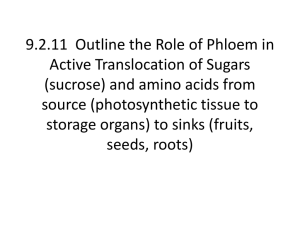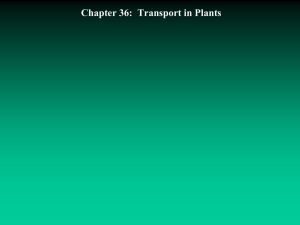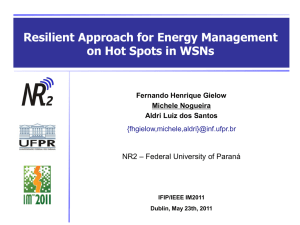In the sink
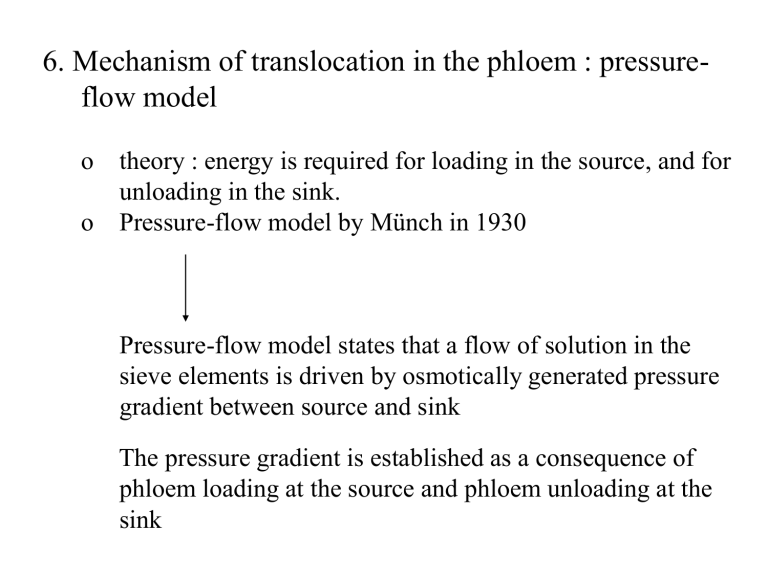
6. Mechanism of translocation in the phloem : pressureflow model
o theory : energy is required for loading in the source, and for unloading in the sink.
o Pressure-flow model by Münch in 1930
Pressure-flow model states that a flow of solution in the sieve elements is driven by osmotically generated pressure gradient between source and sink
The pressure gradient is established as a consequence of phloem loading at the source and phloem unloading at the sink
In the source
①
Energy-driven phloem loading generates a low solute potential in sieve elements
② Water potential drops as a consequence
③ Water enters the sieve elements and causes turgor pressure to increase
In the sink
④
Phloem unloading leads to a higher solute potential
(i.e. lower concentration of sugars) in sieve element of sink
⑤ Water potential of phloem rises above that of xylem
⑥ Water tends to leave phloem
⑦
Causing a decrease in turgor pressure in sieve elements
if no cross-walls present in the translocation pathway, then the different pressures at the source and sink would rapidly approach equilibrium but the presence of sieve plate increase the resistance resulting in generation and maintenance of substantial pressure gradients in sieve elements between source and sink
To satisfy this theory, we have to show several points
1.
Sieve plate pores must not be obstructed, i.e. P-protein or other materials should not block the pores.
2.
Bi-directional transport in a solution can flow in only one direction in a pipe at any one time solutes(sucrose in this case) within the phloem can move bi-directionally, but in different sieve elements
3.
Great expenditure of energy are not required in order to drive translocation in the tissues along the path.
Therefore, treatments restricting the supply or utilijation of ATP such as low temperature, anoxia, metabolic inhibitors should not stop translocation
4.
Pressure-flow hypothesis demands the presence of the pressure gradient i.e. turgor pressure must be higher in sieve elements of sources than in sieve elements of sinks
7. Assimilate allocation and partitioning
The photosynthetic rate determines the total amount of fixed carbon
However, the amount of fixed carbon available for translocation depends on subsequent metabolic events.
The regulation of diversion of fixed carbon into various metabolic pathway is termed allocation
Differential distribution of photo-assimilates within the plant is termed partitioning
Allocation includes storage, utilization and transport of fixed carbon
A. synthesis of storage compounds : starch or fructans
(polymerized fructose molecules)
B. Metabolic utilization : fixed carbon can be utilized in the source leaves such as for synthesis of other compounds or for energy needs
C. Synthesis of transport compounds : sucrose synthesis
Once in the receiver cells,
transport sugars remain as such
transformed into various compounds
accumulate as sucrose
utilized for respiration etc.
-Transport sugars are partitioned among various sink tissues
The greater the ability of a sink to store or metabolize imported sugars (process of allocation), the greater is its ability to compete for assimilate, this process should be synchronized, i.e. shoot and root growth must be balanced
In general, efforts by plant breeders to increase yield by increasing net photosynthetic rates have been unsuccessful.
However, significant improvements in yield have resulted from increases in harvest index
Allocation in source leaves is regulated by key enzymes and hence above figure shows that enzymes involved in each step can control overall distribution
Mechanism for coordinating starch and sucrose synthesis
1. Membrane carrier called by phosphate translocator located in the inner chloroplast membrane
2. Enzyme activities can regulate e.g. sucrose phosphate synthase etc.
e.g.
Sucrose phosphate synthase
Catalyzes the formation of sucrose phosphate, which is subsequently hydrolyzed to sucrose and inorganic phosphate.
High sink demands remove sucrose, pulling the reaction in forward direction
Resulting increase in phosphate release in source cytoplasm
Increase in sink demand
Sink tissues compete for available translocated assimilate
In principle, translocation to sink tissues depends on the position of the sink and on the vascular connection between source and sink
Another factor is competition between sinks removal of sink results in increased translocation to alternative sink.
Sink strength is a function of sink size and sink activity sink strength = ability of a sink to mobilize assimilates toward itself sink size × sink activity rate of uptake of assimilates per unit weight of sink tissue various activities in the sink tissue can limit the rate of uptake by sink
What are the activities in sink tissues?
Unloading from sieve elements
Metabolism in the cell wall (presumably related to expansion of cell size)
Metabolic processes that use assimilate in either growth or storage
The presence and activity of sucrose splitting enzymes acid invertase and sucrose synthase
Sucrose glucose + fructose whether these enzymes control sink strength or are simply correlated with sink metabolism are active topics of research and debate
Changes in source-sink ratio cause long-term alterations in the source

